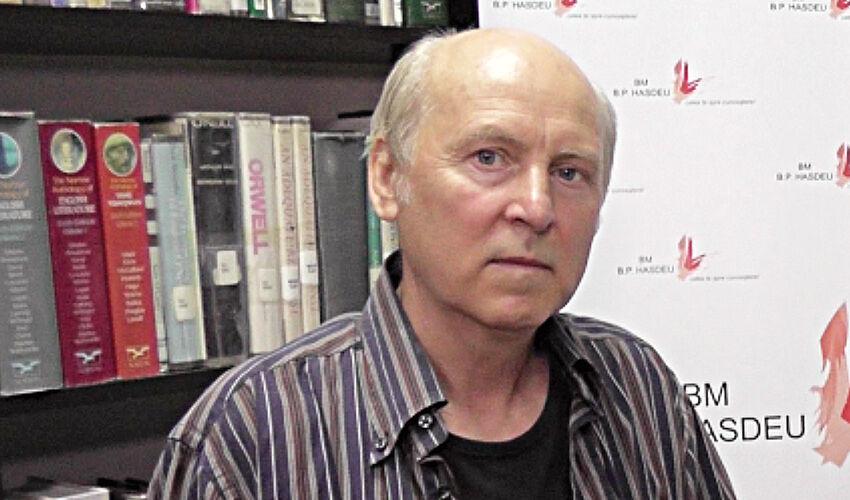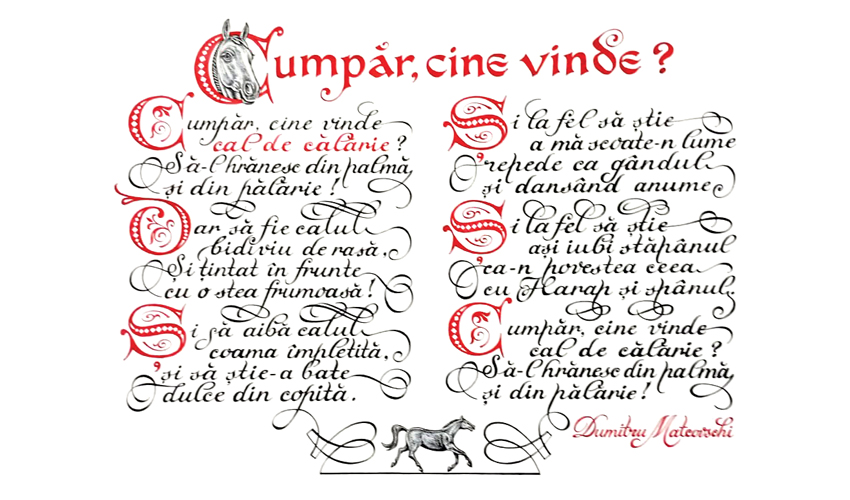
Valeriu Herza
Ilija Bogdesco is recognized as one of the outstanding calligraphers of Moldova and the whole world. He made a significant contribution to the development of Moldovan calligraphy and book graphics, having developed his own “Bogdesco’s Alphabet”. It is a set of capital letters of Cyrillic and Latin alphabets, included in the register of all existing and used today alphabets.
Bogdesko created 15 copies of the handwritten Don Quixote in Russian, English and Spanish. Some copies are in the Hermitage, in the personal collection of the Queen of Great Britain and in the library of the King of Spain.
Valeriu Herta became interested in calligraphy while studying at the Faculty of Architecture of the S. Lazo Polytechnic Institute in Chisinau. At that time there were no books, textbooks on this subject, and my friend and I collected illustrative material by bits and pieces,” Valeriu recalls. – Later, the teacher Grigori Bosenco deepened our knowledge. And I started to use calligraphy when creating graphic posters.
The book “Modern Font” by Estonian calligrapher Villu Toots revolutionized his mind and Valeriu started to study this art in more depth.
Valeriu Herza develops two parallel directions of calligraphy: the thin pen, which was used at school, and the broad pen. The exhibition presented works executed with the broad pen.
On his initiative, the DACIA Calligraphy Association was established in 2019. Crinii Latini contests have been organized for young people for several years. How does the contest go? A phrase is given, for example, “Chisinau – my favorite city”, participants practice writing it at home. On the day of the contest they receive tools and A3 sheets and have to draw it in two hours. The works are evaluated by a professional jury, within half an hour they announce the results and give out cash prizes. The last fact is a good incentive for young calligraphers.
He considers popularization of calligraphy as his mission. Once Herza and Bologa in his village Cupcini held a calligraphy master class at school during a big break, where they told about the art, wrote the children’s names on separate sheets of paper and presented them to them. This summer Valeriu held a retreat of the Association in the Natural and Cultural Reserve “Old Orhei”.
Calligraphy is considered by many to be an elitist art because of its complexity and the demand for highly qualified specialists, especially in the context of the development of unique handwritten scripts and works. It requires special skill, effort and patience, which is not always available to humans in the digital age. However, at the same time, it is accessible to anyone who wants to develop patience and attentiveness, which makes it both an elitist and public art.
There are few people practicing calligraphy in Moldova, Valeriu Herta noted. Among them are Alexei Colibneac, Alexandru Macovei, Alexandru Codimschii, who organized calligraphy courses.

In recent years, hand writing has been disappearing due to digitalization, as people increasingly use electronic devices for communication. “However, the Japanese have concluded in a study that studying calligraphy more than any other activity develops thinking, improves concentration, fine motor skills, eye-handedness and coordination, and develops a sense of rhythm,” says Herza. – And in firms they invite masters, pause for 15 minutes for the master to teach calligraphy classes. It is also used in medicine to develop joint mobility in elderly people or people who have problems with hand mobility. Because thanks to calligraphy you can develop both fingers and the whole joint”.
Willu Toots asserted: “Without calligraphy there is no beautiful book. And without a beautiful book there is no true culture”. Calligraphy is an integral part of the world culture, it appeared and developed together with the appearance of writing thousands of years ago and had a significant impact on the development of the human brain. What distinguishes it from other activities? Harmony of form, symmetry, variety, repetition, hand tension, concentration, control and the appearance of new and new samples of creativity on paper.
Some typefaces have evolved over hundreds of years. Many modern fonts used in computers are designed by calligraphers from different countries. In England, for example, there is a whole institute dedicated solely to fonts. Calligraphy is used in various spheres, such as graphic design (logos, fonts), polygraphy (invitations, cards, diplomas), branding, tattoos, as well as in art (graffiti, wall painting, art objects).
“Some countries are open to the art of calligraphy, we have less,” comments Valeriu Herza. – But we try to pass on the knowledge and love of script to the young. I teach calligraphy as an elective subject at the Pedagogical University. We study only one font – Italian handwritten script”.
Valeriu Herta is sure that despite the development of digital technologies, the art of beautiful writing has a future. Including in Moldova.













